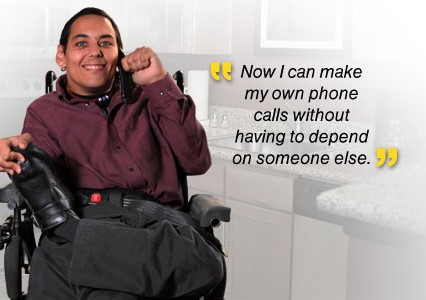 For people with disabilities in the areas of physical, speech, hearing, vision, or cognition, there are many free or low-cost assistive technology devices and adaptations for smartphones and basic cellphones. Many times the people we work with already have these technologies in their possession, and they don’t even know it!
For people with disabilities in the areas of physical, speech, hearing, vision, or cognition, there are many free or low-cost assistive technology devices and adaptations for smartphones and basic cellphones. Many times the people we work with already have these technologies in their possession, and they don’t even know it!
Last week, for example, we met with a woman at our Fargo ND ASSISTIVE Demonstration Center because she could not see to dial on her basic cellphone due to macular degeneration. One of our AT Consultants enlarged the font size on her phone, turned on voice dialing through her address book, and started the talking digit dialing feature. All of these technologies were already on her phone, she just had no idea they were there or how to turn them on. We then combined those aids with a no-cost alerting system with flashing lights and a bed shaker from our ND Telecommunications Equipment Distribution Program, and she was communicating on the phone once again!
Over the past 5 years, we have written about many of these technologies in various blogs. For today’s blog and in the coming months, we thought we would bring it all together for you, to eventually create a reference guide for cell phone assistive technology. In the last post, we will provide you with a collective document that you can download, save, share, and print. Although this guide will not be all-encompassing, it will give you a starting place and an idea of the amazing technologies available today to keep everyone “talking”!
If you find yourself or someone you know in need of the technology discussed, ASSISTIVE can help. We currently run two programs that help individuals with disabilities connect with others via the telephone and other telecommunications technology, the ND Telecommunications Equipment Distribution Program and the ND iCanConnect Program. If you would like more information on either program or our other services to help get you connected, please call 1-800-895-4728 or email us at info@ndassistive.org.
Cellphone Accommodations for Speech
Speech-to-Speech Relay (STS Relay)
You may have heard of the Telecommunications Relay Service (TRS) available for people with hearing loss. Speech to Speech (STS) Relay is another form of free Relay services, which according to the Federal Communication Commission, “enables persons with a speech disability to make telephone calls using their own voice (or an assistive voice device). Like all forms of TRS, STS uses Communications Assistants (CAs) – to relay the conversation back and forth between the person with the speech disability and the other party to the call. STS CAs are operators who are specifically trained in understanding a variety of speech disorders, which enables them to repeat what the caller says in a manner that makes the caller’s words clear and understandable to the called party.”
For more information, you can check out the ND Relay website and the Sprint Relay website.
Telecommunications Relay Service Apps
There are free Telecommunications Relay Service Apps available that those with a qualifying speech disability can use to communicate. Most recently we have been using the Sprint Relay app for mobile devices with our clients. Once you sign up for this free service and set it up on your smartphone, you can communicate with individuals like you would on a traditional landline-based TTY. Meaning that you type your message> the relay operator relays the message> your caller listens>your caller speaks>the relay operator relays the message to you>you read the message.
911 Texting in North Dakota
You are now able to use texting to contact 911 in the state of North Dakota. Last year I wrote a blog on this topic.
Using Your Cellphone with a Speech Generating Device
There are a few ways to communicate on a cell phone with a speech generating device (SGD).
- Turn on the built-in speaker on your cell phone and talk with your SGD as you normally would
- Use a Bluetooth mic/speaker like this one from Motorola for louder more clearer conversations
- Some SGDs can connect directly with a cell phone via Bluetooth or other technology like the devices from Tobii Dynavox and allow for a regular telephone conversation
Texting with an SGD or Speech Generating Communication App
Some SGDs and speech-generating communication apps allow one to create a text message with the pictures and words of their communication system. They can then send or “Share” that message directly from the communication app to the text messaging app, email, Facebook, etc. of the user’s connected smartphone If they do not have the ability to read the message from their communication partner, they can use the built-in text-to-speech available on most smartphones. Some of the devices from Tobii-Dynavox, as well as other manufacturers, have this capability.
Marco Polo Video Walkie Talkie App
This free app allows one to use their smartphone to create videos to communicate walkie-talkie style or respond when it is convenient. The videos are stored on their server, so it does not take up space on either phone. This also allows one to record much longer video messages than through traditional texting.
We recently used this with a person with ALS, who was not ready for a voice output communication device. This person’s speech was hard to understand, and the family had a much easier time interpreting the person’s speech when they could see them on video. It is also much more convenient to be able to create a video when the person and their staff (if needed) have time rather than to have to wait to schedule a video call.

